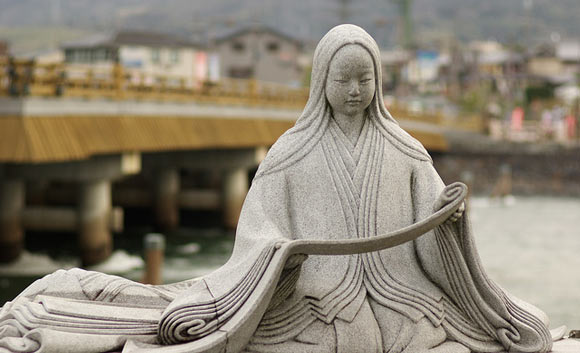Murasaki Shikibu invented “Psychological Novel”
Murasaki Shikibu was a Japanese novelist and courtier who lived during the Heian period. She was born in 973 AD to the Fujiwara family. Her real name is unknown, which was considered normal for daughters at that time. She got the nickname Murasaki which means “purple wisteria blossom” after one of the characters in her novel “The Tale of Genji“. Shikibu refers to an official position held by her father. Her father was a well-known scholar and the governor of a Japanese province.
In those days, husbands and wives lived in separate households, with the children raised in the mother’s household. Murasaki, however, lived with her father as her mother had passed away when she was an infant. Murasaki’s father taught her at home, and she was noted to be an exceptional student. She learned the Chinese classics at home when they were being taught to her brother and became extremely proficient. It was against the permitted traditions of those times for women to learn Chinese, and Murasaki often had to keep her knowledge of the language a secret. She also learnt more traditional subjects such as music, calligraphy and Japanese poetry.
Murasaki was married somewhere between her mid-twenties to early thirties which was unusual for her time as women were usually married on reaching puberty. She remained in her father’s household and wrote poetry which she exchanged with other women. Women in those days did not socialize with other men before her marriage, and the only men she was exposed to were her father and brother. Her marriage did not last long as her husband passed away two years after their marriage. Her only child was a daughter, Kenshi, born in 999 AD. Around this time, she began to write her most famous novel “The Tale of Genji” which is considered to be a classic and possibly, the world’s first novel. Murasaki was devastated at her husband’s death which probably prompted her to indulge herself further in writing. She also had domestic help to run the household which allowed her to spend most of her time in literary pursuits.
In 1005 AD, she was invited to be a lady in waiting at the Imperial Court of Empress Shoshi. At court, Murasaki began to keep a diary of her life which is the most authentic source of information about her. Court life at that time consisted mainly of artistic endeavors as the nobility lived in seclusion from the masses. Court rivalries were rife, with noblewomen setting up their own courts to outdo each other. Women at court dressed up fashionably, usually had floor-length hair, wore white makeup on their skin, and blackened their teeth. They wrote poetry and literature and kept diaries of their love affairs and court events. Japanese court literature during the Heian period is recognized as some of the best literature written in early Japan.
The Empress Shoshi was a teenager when Murasaki joined her court. She was a serious young woman and surrounded herself with talented writers and artists. Murasaki taught the Empress Chinese, who later had screens installed in the palace with Chinese writing. This caused an outrage as Chinese was considered the language of men and used in government, a privilege that was not allowed to women. This earned her the nickname of “Our Lady of the Chronicles”. Murasaki was not fond of court life, which she found frivolous, and was often withdrawn and serious. Towards the end of her life, Murasaki left court service. Her precise date of death is unknown, with some writers quoting 1014 and others quoting 1025. Her legacy as an illustrious novelist and poet is illustrated in many Japanese paintings from the time. Her daughter Kenshi also entered court service and became a famous poet.
